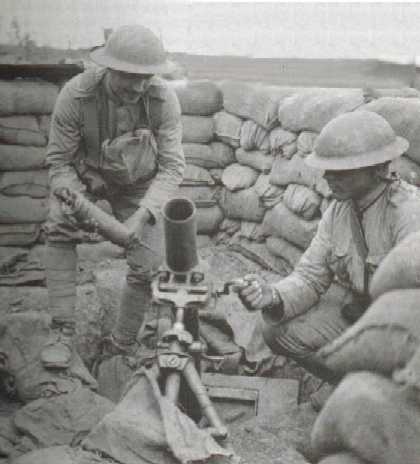
07-07-2009, 01:16 PM
|
 |
Administrator
|
|
|
|
 Stokes Mortar
Stokes Mortar
The Stokes trench mortar was one of the most revolutionary weapons to come out of the Great War. It was invented by an Englishman, Sir Wilfred Scott-Stokes (1860—1927) who was the managing director of a mechanical engineering firm. Although he didn't have a military background, he quickly understood the need for a "portable gun". He started designing one, and had a working prototype of a trench mortar ready for testing in December of 1914, just four months after the outbreak of the war.

The Stokes Mortar was a remarkably simple weapon - something that sceptics at first used against it - consisting of an unrifled metal tube fixed to a base plate (to absorb the recoil) with a lightweight bipod mount that could be adjusted for range. The weapon was broken down into three sections for easy transport — the barrel (which weighed 19.5 kg), the base plate (12.7kg) and bipod (16.7kg) for a total of 49kg.
The range was adjusted by varying the amount of explosive propellant attached to each shell (or "bomb") and adjusting the tube's angle of elevation. The mortar was sighted by a clinometer and by simply lining it up with the target (with the help of a white line painted on the tube). When a mortar bomb was dropped into the tube, an impact sensitive primer in the base of the bomb would make contact with a firing pin at the base of the tube, and detonate, shooting the bomb towards the target.
The cast iron mortar bombs were 7.62cm in diameter and weighed around 4.5 kg. They looked like long tubes, with a protruding stub at the rear end. They were fitted with a modified hand grenade fuse on the front, with a perforated tube containing a propellant charge and an impact-sensitive cap at the rear. They had no stabilising fins, to stabilize them in flight. Stokes proposed to introduced such, but that was rejected in order to ease the production.
 
The Stokes Mortar could fire as many as 30 grenades per minute and had a maximum range of some 1100 m. Due to exploding fragments, the minimum safe range was about 90-100 meters. The limiting factor was often simply the supply of ammo.
 
It has been said that the 3-inch Stokes mortar revolutionized infantry tactics. It gave infantry a weapon with the power of the basic field gun and yet it could be man-carried onto the battlefield. It became the standard issue for the British army, and was used by most Allied armies, including the French, ANZAC, Portugese and American. Indeed, most mortars in use today are direct descendants of the Stokes mortar, while the systems it came up against, mainly the complicated and cumbersome German trenchmortars, are now museum pieces.
The photos below show a WW1 Stokes mortar, ex-French Army, in the French Army Museum in Paris:     


|